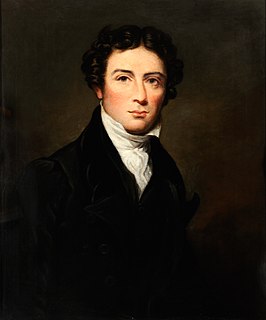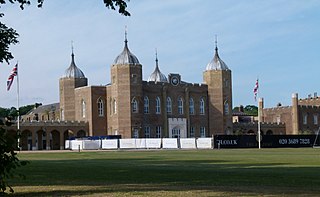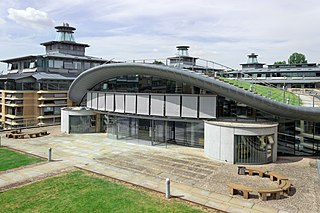Related Research Articles

Electric charge is the physical property of matter that causes charged matter to experience a force when placed in an electromagnetic field. Electric charge can be positive or negative. Like charges repel each other and unlike charges attract each other. An object with an absence of net charge is referred to as neutral. Early knowledge of how charged substances interact is now called classical electrodynamics, and is still accurate for problems that do not require consideration of quantum effects.

Michael Faraday was an English scientist who contributed to the study of electromagnetism and electrochemistry. His main discoveries include the principles underlying electromagnetic induction, diamagnetism and electrolysis.

Natural science is one of the branches of science concerned with the description, understanding and prediction of natural phenomena, based on empirical evidence from observation and experimentation. Mechanisms such as peer review and repeatability of findings are used to try to ensure the validity of scientific advances.

The Cavendish Laboratory is the Department of Physics at the University of Cambridge, and is part of the School of Physical Sciences. The laboratory was opened in 1874 on the New Museums Site as a laboratory for experimental physics and is named after the British chemist and physicist Henry Cavendish. The laboratory has had a huge influence on research in the disciplines of physics and biology.

The University of Göttingen, officially the Georg August University of Göttingen, is a public research university in the city of Göttingen, Germany. Founded in 1734 by George II, King of Great Britain and Elector of Hanover, and starting classes in 1737, the Georgia Augusta was conceived to promote the ideals of the Enlightenment. It is the oldest university in the state of Lower Saxony and the largest in student enrollment, which stands at around 31,600.

William Whewell was an English polymath, scientist, Anglican priest, philosopher, theologian, and historian of science. He was Master of Trinity College, Cambridge. In his time as a student there, he achieved distinction in both poetry and mathematics.

Sir John Edward Lennard-Jones was a British mathematician and professor of theoretical physics at the University of Bristol, and then of theoretical science at the University of Cambridge. He was an important pioneer in the development of modern computational chemistry and theoretical chemistry.

The Royal Military Academy (RMA) at Woolwich, in south-east London, was a British Army military academy for the training of commissioned officers of the Royal Artillery and Royal Engineers. It later also trained officers of the Royal Corps of Signals and other technical corps. RMA Woolwich was commonly known as "The Shop" because its first building was a converted workshop of the Woolwich Arsenal.

Richard Watson (1737–1816) was an Anglican bishop and academic, who served as the Bishop of Llandaff from 1782 to 1816. He wrote some notable political pamphlets. In theology, he belonged to an influential group of followers of Edmund Law that included also John Hey and William Paley.

The Faculty of Mathematics at the University of Cambridge comprises the Department of Pure Mathematics and Mathematical Statistics (DPMMS) and the Department of Applied Mathematics and Theoretical Physics (DAMTP). It is housed in the Centre for Mathematical Sciences site in West Cambridge, alongside the Isaac Newton Institute. Many distinguished mathematicians have been members of the faculty.

The Veritas Forum is a non-profit organization which works with Christian students on college campuses to host forums centered on the exploration of truth and its relevancy in human life, through the questions of philosophy, religion, science, and other disciplines. The organization, named after the Latin word for truth, aims to "create university events engaging students and faculty in exploring life's hardest questions and the relevance of Jesus Christ to all of life." The first Veritas Forum was held at Harvard University in 1992. By 2008, 300,000 students had attended over 300 forums at 100 campuses across the US, Canada, France, England, and the Netherlands. In the 2010–2011 academic year, Veritas Forums were held at over 50 institutions of higher education. Veritas Forums are available for viewing online, and the organization has published several books with InterVarsity Press.
Colin Archibald Russell was Emeritus Professor of History of Science and Technology at the Open University and was a research scholar affiliated to the History and Philosophy of Science Department, Cambridge University. His chief research interests were in the fields of the history of chemistry, environmental history and history of science and religion.
Morris Birkbeck Pell was an American-Australian mathematician, professor, lawyer and actuary. He became the inaugural Professor of Mathematics and Natural Philosophy at the University of Sydney in 1852, and continued in the role until ill health enforced his retirement in 1877. He was for many years a member of the University Senate, and councillor and secretary of the Royal Society of New South Wales.
References
- ↑ Wakefield, Gilbert (1804). Memoirs of the life of ---,B.A. formerly Fellow of Jesus College, Cambridge in two volumes. J.Johnson. p. 83.
- ↑ Robert Fox and Lois Gray, The Hard Progeny of the North. The life and work of eight north country scientists. Lancaster, 1976. Library Shelf-mark AK44L
- ↑ Slinn, Sara (2017). The Education of the Anglican Clergy, 1780–1839. Woodbridge: Boydell and Brewer. pp. 129–169. ISBN 978-1-78327-175-7.
- ↑ Archer, Mary D.; Haley, Christopher D. (6 January 2005). "3. Richard Watson; gaiters and gunpowder". The 1702 Chair of Chemistry at Cambridge: Transformation and Change. Cambridge University Press. p. 79. ISBN 9780521828734.
- ↑ Russell, Colin A. (4 January 2001). Michael Faraday: Physics and Faith. Oxford University Press. p. 15. ISBN 9780190283551.